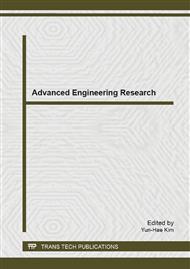p.345
p.349
p.356
p.362
p.366
p.372
p.377
p.381
p.385
Experimental Studies on Triple-Chamber Piezoelectric Pump with Triple Vibrators under Different Working Modes
Abstract:
The structure and working principle of serial-connection 3-chamber PZT pump was introduced, and the output performance of the PZT pump was analyzed under different working modes. The pump was tested, respectively, first with each of the three actuators at different location being actuated solely, and then with random two of the three actuators at different location being actuated (in anti-phase) synchronously. The test results show that changing the driving strategy can change the output performance of the piezoelectric pump, with the structural parameters, working parameters and connection Strategy determined. At a voltage of 150 V, the maximal flowrate and optimal working frequencies for the pump under working mode of left, middle, right chambers actuated solely are 9/7.5/11 ml/min and 260/380/720 Hz respectively. The maximal flowrate and the optimal working frequency for the pump under working mode of left and middle chambers/middle and right chambers actuated synchronously are 17/28 ml/min and 460/600 Hz respectively.
Info:
Periodical:
Pages:
366-371
Citation:
Online since:
April 2014
Authors:
Keywords:
Price:
Сopyright:
© 2014 Trans Tech Publications Ltd. All Rights Reserved
Share:
Citation:


